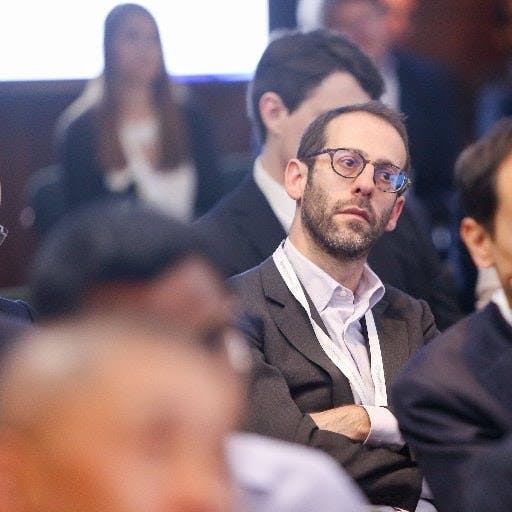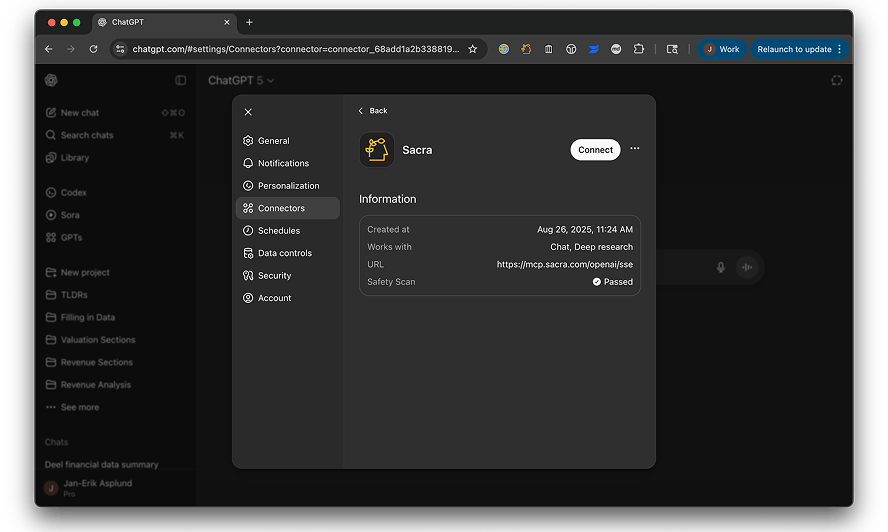Hey everyone!
This Thursday, July 8 at 10:00am PT / 1:00pm ET we’re hosting a live Q&A chat in Discord with this week’s TCT guest, Marc Rubinstein, author of Net Interest and former hedge fund manager, to talk about Fintech valuations today with a historical perspective of the financial industry.
This event is for Sacra members, but we do have a limited number of extra seats, so reply to this email if you’d like to attend.
Marc Rubinstein is a Managing Partner at Fordington Advisors & author of Net Interest, a weekly newsletter distilling Marc's 25 years of experience in the financial sector. Net Interest has over 20,000 weekly readers, including CEOs at top financial institutions.
Marc spent ten years as a partner of an award-winning hedge fund. Before that he was a top-rated analyst at an investment bank. He's also an active angel investor in Fintech companies including Revolut, iwoca, moo.la (acquired), Arthur Online (acquired), Sugar Cap, Level Financial Technology, Bottlepay, and Fronted.

TCT: You began your career as a sell side analyst covering financial services. Since then you have taken entrepreneurial steps towards opening your own fund and writing substack for a large audience. What led to these changes and what are some of the turning points in your career?
Marc: Well, I didn’t exactly open my own fund; I was fortunate to join a group of people who had already started the fund under the umbrella of an established firm. I had decided that rather than advising clients which stocks to buy and sell, I wanted to do it myself, which is why I made the jump. We grew the fund to $4 billion assets under management – it was very exciting.
The switch into the role of an investor was certainly one of the key turning points in my career. It was just before the financial crisis, and it gave me a ringside seat. The financial crisis started on financial companies’ balance sheets, and as someone who spent a lot of time analysing those balance sheets, I had a head start seeing what was going on.
Another turning point was quitting ten years later. Investing other people’s money carries huge responsibility. It requires a degree of focus that is difficult to sustain over many years.
TCT: What's been the biggest challenge of running a fund?
Marc: There’s a great saying, “In life the challenge is not so much to figure out how best to play the game; the challenge is to figure out what game you’re playing.” [Kwame Anthony Appiah]
The hard part about running a fund is that the game you’re playing changes continuously as markets shift. The challenge is truly understanding those changes and keeping up with them.
TCT: You met Warren Buffett in 2017. What are some of your key takeaways from that meeting?
Marc: My main takeaway was something he said about lifelong learning. He said: “You should be learning all the time from what’s around you. I don’t think you can be as wise about people at twenty as you can be at fifty… You need a lot of human experiences to improve your insights.” My Substack was partly inspired by these words. It gives me an outlet to write down some of the things I’m learning and I hope my accumulated experience adds perspective on what I’m seeing.
TCT: You produce a high quality substack newsletter, please share with us what’s your weekly schedule in writing and editing your newsletter? What’s been challenging and what gets easier over time?
Marc: When I started, in May 2020, I was worried that I would run out of things to write about on a weekly basis. But that hasn’t been the case! There’s always something to write about in the field of finance, be it fintech or investment cycles or even fraud. My ‘to write’ list is getting longer, not shorter.
The fascinating part is not knowing in advance what is going to hit and what is going to miss. Some weeks I write what I think is my best ever work and it disappears into the ether without a murmur; other weeks I publish something I think ‘meh’ and it creates a buzz. The observation has taught me two things: don’t second guess what readers want, and keep at it – week after week. I now have nearly 20,000 readers including top investors and CEOs and the feedback loops it has created have been very positive.
TCT: How has your investing style changed over the years? What/who influenced your thinking the most?
Marc: The sell side teaches great technical skills, but poor investing skills. One of the skills I had to learn as an investor was how to size positions. A large fraction of portfolio investments do not work out; the key is to appropriately size the ones that do. So my style changed to pay attention to sizing more carefully.
I also became more long term focussed. The sell side is incentivised to promote turnover but there are no rewards for turnover in investing. And related to that, market timing is extremely difficult. Some people have an incredible talent for reading which way the market is headed, but that’s not me. I don’t know when the best days nor the worst days are coming, so I prefer to stay invested and minimise my turnover. (The S&P Index returned 7.2% annually from 1998 to 2017 but if you missed the best 20 days over those 20 years, your return would have been just 1.1%).
Also related, I love the intellectual rigour involved in shorting stocks. But the asymmetric payoff makes holding on to shorts difficult, so it’s not something I do as much.
TCT: How do you balance seeing both the forest and the trees? What are some examples?
Marc: I usually start with the forest. I’ve met investors who know very little about the trees, they are entirely macro focused and hover - in many cases very successfully - at 30,000 feet. I’ve met others who can tell you every last detail about a specific stock. I sit somewhere in the middle. I try to understand the three or so most important drivers of a stock but I’m usually guided to the stock by an insight about the broader environment. I wrote a post on my Substack a few weeks ago about the Irish banks. Two banks are exiting the market which will leave a duopoly in place – an interesting set-up for an investor. That’s the forest. It’s then time to dig into the financials of the two remaining Irish banks to understand the trees.
TCT: Consumer Fintech firms such as neobanks or BNPL pure plays have the upside of internet businesses but the downside of financial service companies. What’s your valuation framework in assessing whether a Fintech firm should be valued like financial services or high growth tech compounders?
Marc: They should always be viewed as financial companies. Given valuation discrepancies it’s no surprise that the companies themselves would rather investors look at them like consumer internet companies. But unlike other consumer internet companies, financial companies can always engineer growth – they give away money! The hard part is getting the money back but that can be months or years down the line, and whether they can do it at all in a downcycle is an unresolved question. Marketplace lenders like Lending Club showed how the air can be sucked out of financial company valuations – and they don’t carry as much risk as a neobank or BNPL play; I wonder if the same is happening to insurtechs (like Root) at the moment?
TCT: Benjamin Graham says "In the short run, the market is a voting machine but in the long run it is a weighing machine". What part of the history do you think can teach us the most about the current market valuation?
Marc: I remember the 1999/2000 period very well. I was a sell side analyst at the time. In fact, it was a time of peak sell side analyst – they/we were in high demand by investment banks wanting the best analysts to bolster their chances of winning IPO business. There are many similarities with that period. Retail interest in the stock market was very high – I remember my friends from outside the industry setting up an investment club; day trading was popular. There was a sense of ‘us’ versus ‘them’ – those that ‘got it’, saw that this was the emergence of a ‘New Economy’ versus those that didn’t. I’m not saying valuations are comparable, and many of the fundamentals are different, but the atmosphere is similar.
TCT: You’ve interviewed many C-suite executives. What is your process in distilling the most important questions to ask management?
Marc: There’s usually only two or three things that are important, so spend most of your time on them. Try not to take notes in the meeting so you can engage fully and make the meeting more conversational. Give them something back – your take on the company or market or some analogy you’ve drawn as an investor.
TCT: What are the trends you are most excited about in Fintech and why?
Marc: I like lending products that traditional banks never offered, either because ticket sizes are too small, or they didn’t have sufficient data. Examples include loans to finance user acquisition. I am an investor in a great company called Sugar Cap which makes loans to games developers to finance their user growth. I am also interested in embedded finance. There’s nothing inherently new to it – car companies have offered financing for years, department stores pioneered point-of-sale credit and real estate agents work closely with mortgage brokers – but technology is reducing the friction further. Finally, I am curious about DeFi and some of the applications of crypto – just curious at this stage, I am not 100% convinced yet, but it’s something I’m looking at very closely.
TCT: Can neobanks expect to ever generate positive NIMs? Will they manage to lend before they run out of PE/VC money?
Marc: Well, it depends on the market. Nubank of Brazil made R$1.6 billion of net interest income last year, a NIM of around 4.3%. It has a large credit card book, where rates can be very high. Tinkoff in Russia isn’t really a neobank – it’s been around since 2006 – but it too generates a lot of interest income from credit card loans. Without high yielding credit cards, it’s certainly difficult to generate NIM, given zero/low interest rates everywhere. Higher rates would help neobanks earn a margin on deposits. Or they can expand into other lending lines. The cautionary tale here though is Monzo, which went into overdraft lending in 2019 and suffered outsized losses.
TCT: What structural advantage do you think Klarna has in comparison to neobanks?
Marc: Klarna has two advantages. It has a lower customer acquisition cost because its merchants subsidise that. And it is already regulated as a bank. Eventually, all these neobank oriented fintechs will need to be regulated as banks; the earlier they develop the infrastructure to accommodate that, the greater their advantage.
TCT: Lending and payments are commodities so would likely see fee compression, hence, market size contraction. At their maturity, would these Fintechs have a more attractive return on equity than traditional banks and why?
Marc: I think as they mature, they will garner increasing regulatory scrutiny. To the extent that imposes capital requirements on them, they will have to hold more capital to cover operational risk, credit risk and other typical banking risks. The regulatory piece is often overlooked. Below a certain size, policymakers are happy to leave fintechs be, but over a certain size they intervene. Just look at Ant Group in China.
TCT: Expansion has put a dent in Klarna’s profitability. What’s your view on how the company can gain a cost of funding advantage as it continues to scale its business?
Marc: Traditionally, retail deposits have been the cheapest source of funding. That may be less obvious in a zero/low interest rate environment, but when/if rates rise, deposit costs will tend not to rise as quickly as wholesale funding costs. Klarna’s deposit base is a huge cost of funding advantage.
TCT: Competition is converging in BNPL. By expanding into the US, Klarna not only competes with Affirm, Afterpay, PayPal, Square, but also traditional banks in short duration lending and Google in merchant marketing. How do you see competition unfold in the future? Which part of the value chain would Klarna be able to capture?
Marc: Buy Now Pay Later is going to be a very competitive market. We’ve already seen many new entrants into the market over the past year. Some will compete in specific categories (e.g. health and beauty) or in specific markets. In Klarna’s case, the key will be increasing engagement with consumers.
Follow Marc on Twitter to learn more about FinTech and join us for a Q&A with Marc Thursday July 8 at 10:00am PT / 1:00pm ET by replying to this email for an invite.


